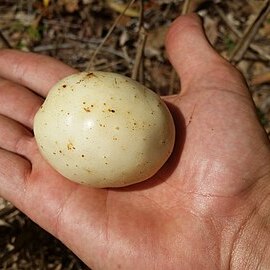Liana to 25 m tall. Stem 25–150 mm diameter; internodes round, glabrous to scabrous, smooth, sometimes covered in glandular secretions. Leaves decussate or ternate, cartilaginous to subcoriaceous, sometimes shiny; blade ovate to elliptic, 90–290 mm long, 52–162 mm wide, apex acute to acuminate, base cordate to rounded, glabrous to scabrous at base and midvein; venation 3-palmate at base; large glands round to oval, crater-like, 0.2–2.2 mm long, 0.6–1.6 mm wide, brownish at base, few; petiole 15–80 mm long, 1.2–3 mm wide, half-terete in cross section, glabrous to scabrous on abaxial surface; glands round, 0.12–0.32 mm diameter, raised, covered or partly covered. Inflorescence 62–350 mm long, 25 mm wide, axillary or terminal, determinate double thyrse with decussate bracts, erect, glabrous to covered with patent trichomes; glands crater-like, 0.06–0.7 mm diameter, few. Calyx campanulate, linear to bulbous, 8–23 mm long, 4–8 mm wide, 1–4 lobes, split irregularly during flowering, erect during flowering, persistent, fleshy to membranous, greenish white to pale green, glabrous to covered with patent transparent trichomes, erect when fruiting; lobes 7–25 mm long, 4–11 mm wide, 0.1–1 mm thick, apex acute to acuminate or mucronate; glands round, crater-like, 0.06–0.9 mm diameter, outside brown, few. Corolla narrowly infundibular, 22–76 mm long, up to 450 mm wide; tube 10–40 mm long, 2–7 mm wide; abaxially glabrous or middle to apex with few multicellular transparent trichomes, white or greenish-white, sweet scented; lobes spathulate to oblong, 5–54 mm long, 6–25 mm wide at base, 8–33 mm wide at apex, erect, apex entire to lobed or emarginate to up to 10 mm. Stamens filaments 16–75 mm long, 0.3–1 mm wide, usually equal, situated in upper third of the tube, exserted to greatly exserted, white; trichomes 0.3–1 mm long, from base to middle part, absent to abundant, multicellular, transparent, patent; anthers 2.5–4 mm long, 1–2 mm wide, glabrous, brownish; pollen white or yellowish orange to yellow. Ovary lobes round, 1–2 mm long, 1–2 mm wide, velutinous to glabrous, light green, sometimes with crater-like glands; style 45–80 mm long, 0.6–1 mm wide, glabrous, white; stigma triangular, 2-lobed, 0.2–1.5 mm long. Disk 0.5–1.4 mm long, 1.6–3.5 mm wide, glabrous, light green. Fruit ellipsoid to ovoid, falcate, white to pale or creamy yellow; fresh mericarp 55–70 mm long, 45–55 mm wide; dry mericarp 38–60 mm long, 18.2–30 mm wide, 17–30 mm thick, sparingly scabrous; glands round, 1–1.5 mm diameter; seed coat 1–3 mm thick, with 2 mm high irregular ridges. Seed smooth.
More
It is an evergreen climbing vine. It climbs to a height of 15 m. The stem is vigorous. The leaves are light green and glossy. They are oval or narrowly heart shaped. They are 10-40 cm long and 6-8 cm wide. The leaf stalks are 2-5 cm long. The leaves are fairly thin textured with glands at the base of the leaf blade. The flowers are white. They have 4 lobes and are cup shaped. They are 5 cm across. The occur in clusters at the ends of branches. The flowers have a scent. The fruit are cream coloured oval berries. They are 9 cm long by 6 cm across. They are edible. The white flesh of the fruit turns yellow when squashed. There is one seed inside. The seed is 4.5 cm long by 3.5 cm wide.

